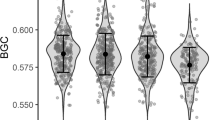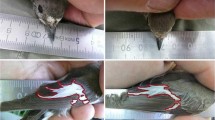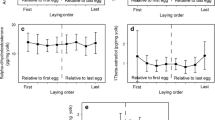Abstract
Vertebrate eggs contain maternal steroid hormones in their yolks; and in avian species the concentration of these steroids vary within and among clutches. The organizational actions of these variable doses of maternal steroids in the avian egg, analogous to those regulating the development of sexually dimorphic traits, are little explored. In this study, we examined the organizational effects of yolk testosterone in the house sparrow, Passer domesticus, a sexually dichromatic passerine bird in which males are characterized by the presence of a throat patch or “badge” of black feathers that varies in size among males. We injected a physiological dose of testosterone or vehicle into eggs in the field, removed nestlings, and hand-raised them in the laboratory. At 5 months of age, we investigated treatment effects on plumage and behavior. Males that hatched from testosterone-injected eggs developed a larger badge than males that hatched from vehicle-injected (control) eggs. However, testosterone did not induce the expression of a badge in females. In staged dyadic encounters, both males and females hatched from testosterone-injected eggs were more successful at obtaining and defending a food source than individuals of the same sex hatched from control eggs. The results suggest that variable concentrations of maternal testosterone in the eggs of the house sparrow organize the expression of a plumage trait in males and behavior in both sexes.




Similar content being viewed by others
References
Arnold AP (2002) Concepts of genetic and hormonal induction of vertebrate sexual differentiation in the twentieth century, with special reference to the brain. In: Pfaff E, et al (eds) Hormones, brain, and behavior, vol 4. Academic, New York, pp 105–135
Arnold AP, Breedlove M (1985). Organizational and activational effects of sex steroid hormones on vertebrate behaviour. Horm Behav 19:469–498
Badyaev AV, Hill GE, Beck ML, Dervan AE, Duckworth RA, McGraw KJ, Nolan PM, Whittingham LA (2002) Sex-biased hatching order and adaptive population divergence in a passerine bird. Science 295:316–318
Bernardo J (1996) Maternal effects in animal ecology. Am Zool 36:83–105
Bowden RM, Ewert MA, Nelson CE (2000) Environmental sex determination in a reptile varies seasonally and with yolk hormones. Proc R Soc B Biol Sci 267:1745–1749
Conley AJ, Elf P, Corbin CJ, Dubowsky S, Fivizzani A, Lang JW (1997) Yolk steroids decline during sexual differentiation in the alligator. Gen Comp Endocrinol 107:191–200
Crews D (1998) On the organization of individual differences in sexual behaviour. Am Zool 38:118–132
Eising CM, Groothuis TGG (2003) Yolk androgens and begging behaviour in black-headed gull chicks: an experimental field study. Anim Behav 66:1027–1035
Eising CM, Eikenaar C, Schwabl H, Groothuis TGG (2001) Maternal androgens in black-headed gull (Larus ridibundus) eggs: consequences for chick development. Proc R Soc Lond B Biol Sci 266:765–770
Fox DL (1976) Animal biochromes and structural colors. University of California, Berkeley
Gil D, Graves J, Hazon N, Wells A (1999) Male attractiveness and differential testosterone investment in zebra finch eggs. Science 286:126–128
Gil D, Leboucher G, Lacroix A, Cue R, Kreutzer M (2004) Female canaries produce eggs with greater amounts of testosterone when exposed to preferred male song. Horm Behav 45:64–70
Gonzalez G, Sorci G, Smith LC, Lope F de (2001) Testosterone and sexual signaling in male house sparrows (Passer domesticus). Behav Ecol Sociobiol 50:557–562
Griffiths SC, Owens IPF, Burke T (1999a) Female choice and annual reproductive success favor less-ornamented male house sparrows. Proc R Soc Lond B Biol Sci 266:765–770
Griffiths SC, Owens IPF, Burke T (1999b) Environmental determination of a sexually selected trait. Nature 400:358–360
Groothuis TG, Schwabl H (2002) Determinants of within and among clutch variation in levels of maternal hormones in black-headed gull eggs. Funct Ecol 16:281–289
Hall PF (1969) Hormonal control of melanin synthesis in birds. Gen Comp Endocrinol [Suppl] 2:451–458
Hegner RE, Wingfield JC (1986a) Behavioral and endocrine correlates of multiple brooding in the semi colonial house sparrow Passer domesticus. I. Males. Horm Behav 20: 294–312
Hegner RE, Wingfield JC (1986b) Behavioral and endocrine correlates of multiple brooding in the semicolonial house sparrow Passer domesticus. II. Females. Horm Behav 20:313–326
Hegner RE, Wingfield JC (1987) Social status and circulating levels of hormones in flocks of house sparrows, Passer domesticus. Ethology 76:1–14
Hein WK, Westneat DF, Poston JP (2003) Sex of opponent influences response to potential status signal in house sparrows. Anim Behav 65:1211–1221
Hunt J, Simmons LW (2002) The genetics of maternal care: direct and indirect genetic effects on phenotype in the dung beetle, Onthophagus taurus. Proc Natl Acad Sci USA 99:6828–6832
Janzen FJ, Wilson ME, Tucker JK, Ford SP (1998) Endogenous yolk steroid hormones in turtles with different sex-determining mechanisms. Gen Comp Endocrinol 111:306–317
Jennings DH, Weiss SL, Moore MC (2001) Ontogenetic changes in embryonic yolk steroid content in tree lizards: transfer from the developing embryo to the yolk? Horm Behav 39:334A
Kempenaers B, Verheyen GR, Van den Broeck M, Burke T, Broeckhoven C van, Dhondt AA (1992). Extra pair paternity results from female preference for high quality males in blue tit. Nature 357:494
Kirkpatrick M, Lande R (1989). The evolution of maternal characters. Evolution 43:485–503
Kirckpatrick M, Ryan MJ (1991) The evolution of mating preferences and the paradox of the lek. Nature 350:33–38
Liker A, Barta Z (2001) Male badge size predicts dominance against females in house sparrows. Condor 103:151–157
Lipar JL, Ketterson ED (2000) Maternally derived yolk testosterone enhances the development of the hatching muscle in the red-winged blackbird, Agelaius phoeniceus. Proc R Soc Lond B Biol Sci 267:2005–2010
Lipar JL, Ketterson ED, Nolan V Jr (1999) Intraclutch variation in testosterone content of red-winged blackbird eggs. Auk 116:231–235
Lovern MB, McNabb A, Jennson FM (2001). Developmental effects of testosterone on behavior in male and female green anoles (Anolis carolensis). Horm Behav 39:131–143
Mazuc J, Chasel O, Sorci G (2003) No evidence for differential maternal allocation to offspring in the house sparrow (Passer domesticus). Behav Ecol 14:340–346
McCormick MI (1998) Behaviorally induced maternal stress in a fish influences progeny quality by a hormonal mechanism. Ecology 79:1873–1883
Møller AP (1987) Variation in badge size in male house sparrows Passer domesticus: evidence for status signaling. Anim Behav 35:1637–1644
Møller AP (1988) Badge size in the house sparrow Passer domesticus: effects of intra- and intersexual selection. Behav Ecol Sociobiol 22:373–378
Møller AP (1989) Natural and sexual selection on a plumage signal of status and on morphology in house sparrows, Passer domesticus. J Evol Biol 2:125–140
Møller AP (1990) Sexual behaviour is related to badge size in the house sparrow Passer domesticus. Behav Ecol Sociobiol 27:23–29
Møller AP (1999) Good-genes effects in sexual selection. Proc R Soc Lond B Biol Sci 266:85–91
Moore MC, Hews DK, Knapp R (1998) Hormonal control and evolution of alternate male phenotypes: generalizations of models for sexual differentiation. Am Zool 38:133–151
Mousseau TA, Fox CW (1998) Maternal effects as adaptations. Oxford University Press, New York
Mueller NS (1977) Control of sex differences in the plumage of the house sparrow, Passer domesticus. J Exp Zool 202:45–48
Norris K (1993) Heritable variation in a plumage indicator of viability in male great tits Parus major. Nature 362:537-539
Petrie M (1994) Improved growth and survival of offspring of peacocks with more elaborate trains. Nature 371:598–599
Phoenix CH, Goy RW, Gerall AA, Young WC (1959) Organizing action of prenatally administered testosterone propionate on the tissues mediating mating behavior in the female guinea pig. Endocrinology 65:369–382
PilzKM, SmithHG, Sandell MI, Schwabl H (2003) Inter-female variation in egg yolk androgen allocation in the European starling: do high quality females invest more? Anim Behav 65:841–850
Poopatanapong A (2002) Relationship between male badge size and female reproductive investment and mate choice in house sparrow. MSc thesis, Washington State University, Pullman, Wash.
Reed WL, Vleck CM (2001) Functional significance of variation in egg-yolk androgens in the American coot. Oecologia 128:164–171
Reyer HU, Fischer W, Steck P, Nabulon T, Kessler P (1998) Sex-specific nest defense in house sparrows sparrow Passer domesticus varies with badge size of males. Behav Ecol Sociobiol 42:93–99
Rohwer S (1975) The social significance of avian winter plumage variability. Evolution 29:593–610
Rohwer S (1977) Status signaling in the Harris’ sparrow: some experiments in deception. Behavior 61:107–129
Rohwer S, Rohwer FC (1978) Status signaling in Harris’ sparrows: experimental deception achieved. Anim Behav 26:1012–1022
Rohwer S, Wingfield JC (1981) A field study of social dominance, plasma levels of lutenizing hormone and steroid hormones in wintering Harris’ sparrows. Z Tierpsychol 57:173–183
Ruiter AJH de, Feitsma FE, Keijser NJ, Koolhaas JM, Oortmerssen GA van, Bohus B (1993) Differential perinatal testosterone secretory capacity of wild house mice is related to aggressiveness in adulthood. Horm Behav 27:231–239
Saal FS vom, Drickamer LC, Clark MM, Galef BG Jr, Vandenbergh JG (1999) Intrauterine position phenomenon. In: Knobil E, Neil JD (eds) Encyclopedia of reproduction, vol 2. Academic, New York, pp 893–899
Schreck CB, Fitzpatrick MS, Geist GW, Yeoh CG (1991) Steroids: developmental continuum between mother and offspring. In: Scott AP, Sumpter JP, Kime DE, Rolfe MS (eds) Proceedings of the fourth international symposium on the reproductive physiology of fish, vol 2. Academic, San Diego, p. 256
Schwabl H (1993) Yolk is a source of maternal testosterone for developing birds. Proc Natl Acad Sci USA 90:11466–11450
Schwabl H (1996) Maternal testosterone in the avian egg enhances post-natal growth. Comp Biochem Physiol 114A:271–276
Schwabl H (1997) The contents of maternal testosterone in house sparrow Passer domesticus eggs vary with breeding condition. Naturwissenschaften 84:406–408
Schwabl H, Mock D, Gieg J (1997) A hormonal mechanism for parental favoritism. Nature 386:231
Sockman KS, Schwabl H (2000) Yolk androgens reduce offspring survival. Proc R Soc Lond B Biol Sci 267:1451–1456
Summers-Smith JD (1988) The sparrows: a study of the genus Passer. Poyser, Calton
Tschirren B, Richner H, Schwabl H (2004) Ectoparasite-modulated deposition of maternal androgens in great tit eggs. Proc R Soc Lond B Biol Sci DOI:10.1098/rspb.2004.2730
Vaclav R, Hoi H (2002) Different reproductive tactics in house sparrows signaled by badge size: is there a benefit to being average? Ethology 108:569–582
Veiga JP (1993) Badge size, phenotypic quality, and reproductive success in the house sparrow: a study on honest advertisement. Evolution 47:1161–1170
Wade MJ (1998) The evolutionary genetics of maternal effects. In: Mousseau TA, Fox CW (eds) Maternal effects as adaptations. Oxford University Press, New York, pp 5–41
Whittingham LA, Schwabl H (2002) Maternal testosterone in tree swallow eggs varies with female aggression. Anim Behav 63: 63–67
Wolf JB, Brodiew ED, Cheverud JM, Moore AJ, Wade MJ (1998) Evolutionary consequences of indirect genetic effects. Trends Evol Ecol 123:64–69
Acknowledgements
We thank Bryce Duskin and Matt Leland for help in scoring behavior tapes and Chris Clark for assistance in raising the sparrows. Diego Gil, Marion Petrie, and Michael Webster offered helpful discussions and comments on earlier drafts of this manuscript. This research was supported by grants from the National Institutes of Health (MH 4987 to H.S., HD F32HD08542 to R.S.) and the Harry Franck Guggenheim Foundation (to H.S.).
Author information
Authors and Affiliations
Corresponding author
Additional information
Communicated by J. Graves
Rights and permissions
About this article
Cite this article
Strasser, R., Schwabl, H. Yolk testosterone organizes behavior and male plumage coloration in house sparrows (Passer domesticus). Behav Ecol Sociobiol 56, 491–497 (2004). https://doi.org/10.1007/s00265-004-0810-9
Received:
Revised:
Accepted:
Published:
Issue Date:
DOI: https://doi.org/10.1007/s00265-004-0810-9




